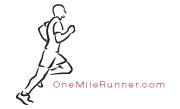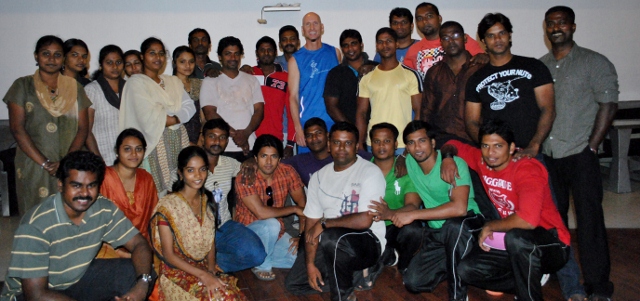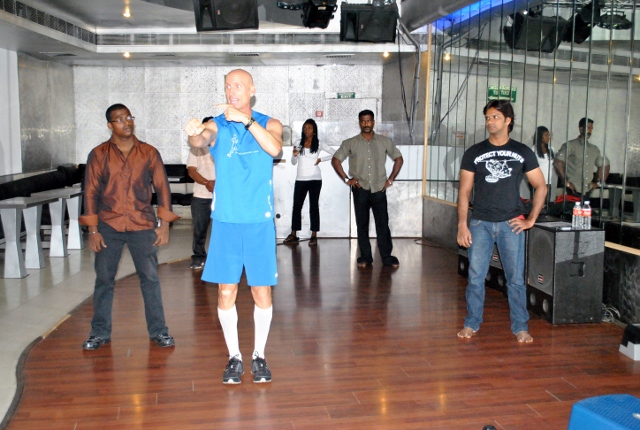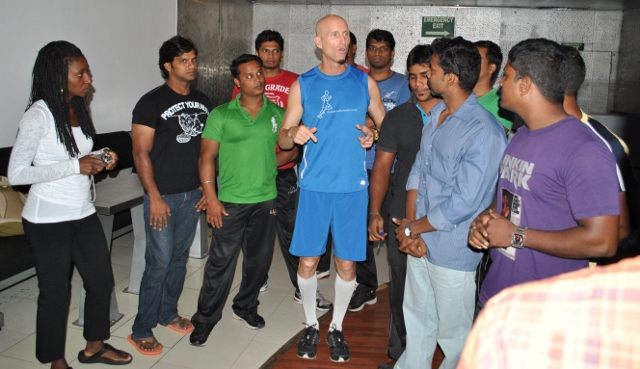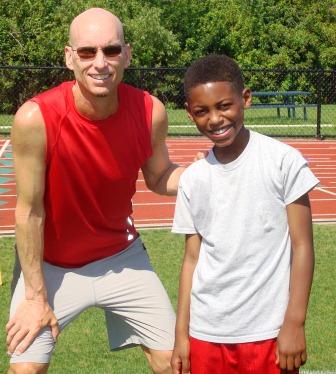I attended our high school regional cross country championships and a pro tennis tournament yesterday. I wanted to observe two of my athletes compete. One at the cross country meet before I begin his speed preparations for track season and a tennis player before I prepare his 2013 schedule. I learned a great deal by seeing the race and the match in person. With all the statistics and other various numbers that computer programs spit out, for me there is no comparison to actually being at the event. I know it might sound like “old school” to some, but I need to use my senses to watch live action, hear the sounds, and feel the intensity of competition. It is what has kept me in love with live sports since I was a youth and developed my instincts as a coach.
It was indeed a day of contrasts. The runner ran a personal best falling over after crossing the finish line in pure exhaustion. The tennis player competed well for a set and then drifted away losing the last 12 of 13 games. I find it interesting why some athletes rise to the occasion and others collapse. Certainly some have not worked or prepared properly, some do not care as much, and some fear competitive situations. Why can’t we try our best in the competition, win or lose with grace and humility, and take responsibility for our actions? It seems so simple, so wonderful, so free. We have been cluttered with so many other thoughts that the joy of competing against others has been tarnished. I am not naive to the fact that there are many things associated to sports success: money, scholarships, and fame. But when I put my toe on the starting line of a race, the only thing that matters to me is the desire to give my best. I just wish the young athletes of today do not miss out on how much enjoyment and satisfaction can come from true competition. My athletes had contrasting realizations yesterday that only competition could bring out. The journey continues…
Category Archives: Topic – Training
How To Achieve Peak Performance
We wanted to share what we learned in this 2012 Isles Mile Challenge experiment that could help you perform at your peak. Remember this is a “buffet” of ideas, please pick or choose what you want that could help you reach your highest level of performance.
1) TRAINING – Our focus in the spring on running up and down the Ringling Bridge to prepare my body for the up and down conditions of the islands worked out great. My training buddy, Wayne, and I set up sprint work, tempo work, and interval work on uneven terrains. We live in Sarasota and train most of the time on surfaces that are very flat, we call the conditions “Florida Flat” (as I have raced in California on so-called flat courses, but they are very up and down compared to Florida).
2) RECOVERY – After 30,000 miles of travel through various time zones, my body held up surprising well. With races every week, one pulled hamstring and the tour was over. No Advil or ice was used to recover – just massage therapy and my Body Protection program. During an interview the other day, the reporter did not believe me at first when I said that I used no medicine at all on the trip, but after he heard of my training – he understood. Not only on this tour did I not get injured, but I also did not get sick. My immune system stayed strong throughout the travel. I took my Vega One shake every morning, followed a strict vegan diet, and had no alcohol.
3) RACING – Prayer, visualization, and a present focus mentality prepared me for the various race conditions. Each race was different, but my mind was the same. There were times I spent hours on the road race course going through the turns and 1/4 mile splits over and over. I wanted to feel like I had raced on this new course before. Getting familiar with the conditions really assisted me in my racing confidence. Also,my focus on my racing form and technique really helped me to stay fast and strong. Charlie Olbrias (our official timekeeper) said that I looked as fast as I did 3 years ago when he followed me to 27 races in 2009. My mile race times this year backed up his observations and assertions.
Now that the summer is over, it is time to set up your fall training, recovery, and race schedule. Please feel free to ask me any questions on how to optimize your efforts as you try to peak in the last quarter of 2012.
Running: 5 Steps to Run A Better Time Trial
The last part for my speed preparation is a time trial. Just me against the clock. Unfortunately, some of my races are just like a time trial (in some of my strange locations) with no other competitors. It is I vs. the clock – that is how my time trials are set up. It does not have to be that way – you can have competitors at a time trial, but for me to properly measure my training and my shape, I prefer to run a time trial solo. I do this to build my mental strength. This is why I find time trials much more difficult than running against other competitors. In a race, you can draft, pace, and use other competitors in your event. In my time trial, I am alone and want to feel that loneliness over a measured distance.
We have set up a half mile time trial on the roads behind my house that I run every year before my tours begin. It helps me build confidence in my body, mind, and spirit. I do not run this time trial all out, instead I use it as a dress rehearsal for my mile race. I warm-up the same way and put my toe on the line just like it is my first race. I want to “feel” what the first half mile should feel like in my mile race. I practice my strong start, my first quarter mile, and then run my second quarter just as I would like in the mile – smooth, relaxed, and rhythmic. I should be around 2:20 for the first half mile.
I ran time trials the last two Saturday mornings running right around 2:20. This practice allows me to race with confidence next week. Here are some points to remember for a good time trial:
1) Warm up fully
2) Race solo or with others – your choice.
3) Choose the same course in order to measure improvement
4) Have a purpose – what are your performance goals?
5) Reflect and repeat the following week
All the best with your speed workouts to help you better prepare for your racing distance. We are off to Ireland on Monday for our first race. Let’s hope the rain will stop just before I put my toe on the line…
Running: 7 Steps to a Better Start
Working on my “start” is part of my speed training. I remember my mistake at The National Masters Indoor Championships in 2006. When the gun went off for the start of the race, I went backwards and not forwards giving up position on the tight 200 meter track. I wanted to start off in a certain group for the mile, but they were already gone. I ran a 4:46 just before my 43rd birthday. I corrected my “start” mistake the following year at the same track in Boston at The National Masters Indoor Championships. After working repeatedly on my start and the initial 100 meters of the one-mile race, I ran a 4:37 just before my 44th birthday. I had earned my qualifying spot for this National Championship and wanted to stay with the leaders for the first 1/2 mile. My good “start” helped me establish position in the lead group and allowed me to keep my race strategy for an improved time in 2007. Now that I am soon embarking on my 5th tour for www.OneMileRunner.com, I am working on my “starts” this month as I prepare for my first race on July 1st.
The shorter the race, the more importance is given to the start. Usain Bolt in the 100 and 200 meters knows how important his “start” is going to be in London next month. From 400 meters and below, sprinters use “starting blocks” to begin their races. Events longer than 400 meters (one lap around the track) do not use “starting blocks”. Even though in longer races the start is not as important, it is still fun speed training and certainly gets you focused on the task at hand.
Here are the 7 keys to a fast start for races that do not use a starting block:
- Line up your feet in a sprint position one ahead of the other. (Decide which foot you would like to have in front – this will be your push off leg).
- Your feet should be about shoulder width apart with your front foot flat and the back foot just touching with your toe. (If you begin with a base too wide, it can cause you to retract backwards at the shot of the gun).
- Whatever foot you have in front, raise your opposite arm up high in a full arm swing position.
- Lean over the starting line (yes, it is legal to lean over) with almost all your body weight on your front foot.
- At the shot of the gun, thrust down and back with raised arm and push off with your front foot at the same time. This will literally launch you off the line to begin your race.
- Keep yourself in full sprint mode to get position at the start of your race and to avoid collisions with other participants’ legs and elbows.
- Maintain your sprint speed for a desired length (somewhere between 60-200 meters depending on the race).
Enjoy the power of your new “start” and begin your race with a bang!
Preparing For The Speed Of The Mile
One of the reasons why I love the workouts for the mile is that every day is different training. Besides all the full body strength training that I do to prepare for the abuse of racing every week, this month of June focuses on training the speed required for the mile. The week started for me in Arizona, where I began my week on Monday with repetitions of 8×1/8 mile sprints, returned to Florida to run a 3 mile tempo run on Thursday, and concluded my speed training on Saturday with 7×1/4 mile on a straight road. This coming Tuesday, I hit the bridge to take advantage of one of the few hills in the city.
Let’s go over each of these different speed workouts so you can understand why you should add them to your workouts:
- 1/8 mile sprints – all-out sprints preparing your muscles to load and explode
- Tempo runs – roughly 20 minutes of “hard running at ease” (breathing is easier) to raise lactate threshold (the breaking point where your muscles fatigue)
- 1/4 mile repetitions – slightly slower than your sprint speed teaching your body to work harder and increase your running efficiency
- Hill repeats – working against gravity improving the strength of muscles and tendons
At 49 years old, I follow my hard runs with a recovery run (30-50 minutes) the next day allowing time for my body to mend, strengthen, and absorb the quality speed workouts. Of course, before you begin your speed workouts get properly warmed-up with light jogging and mobilization exercises, and then conclude the workout with a cool-down of jogging mixed with striding (easy lengthening of your stride) and stretching movements to remove lactic acid created by the speed workout. Please let me know how any of these various speed themes help you to go faster.
Cellulitis hampers first month of training
March was an interesting month as it began with a case of cellulitis of my right ankle and foot. Cellulitis is a skin infection that creates redness, swelling, warmth, and pain. Bacteria enters the body through a small cut or scrape of the skin. Even though I am highly susceptible to skin and blood infections, I have never had cellulitis before, so this was all new to me.
After seeing my doctor and having an ultrasound to be certain that it was not a blood clot, I was sent home to have 10-day regime of antibiotics. I thought I was going to feel no pain after the 10-day cycle of antibiotics, but the tissue damage still remained. The doctor said it could take 4-6 weeks for the underlying tissue to heal completely. Even now, I still cannot tie my shoe as tightly as before. As you can imagine, little changes in my foot plant and push off can alter the way my body runs. I have continued my coaching and training throughout the treatment, but had to back off a bit recently when I experienced some swelling in my right knee due to the changes in my landing. The body is an incredible mechanism as even the slightest alteration can lead to major consequences. The body adapts to compensate for the change and can lead to other problems.
This is our fifth event in the last five years, so we are no strangers to the twists and turns that can take place during a training period or racing schedule. It is all part of The Isles Mile Challenge preparation and learning. It made for an unusual first month of training, but we will keep you updated every week as we get ready for our first race in Greece on July 1st.
O2 Health Studio Clinic In Chennai, India
We have been spending the week in my old “hometown” of Chennai, India where I lived for 5 years from 1986-91. We have been the guests of O2 Health Studios as we led a “Body Protection” fitness clinic to all their trainers and physiotherapists. Tomorrow we finish with a “Creating Amazement” seminar with the managers of O2. From Hyderabad to Chennai, it has been great to spend this time in southern India sharing our fitness concepts.
I went over some of the basic movements of my “Body Protection” program and then showed some of the resistance moves. The O2 trainers participated in learning the moves in order to protect their bodies from injury and prepare their bodies for speed and power. We went over some of the fitness myths that need to broken in order to take our athletic performances to the next level. We will address these fitness myths in our upcoming “Body Protection” video.
We fly north to New Delhi on Sunday morning. Take a train to Agra and get ready to race at the Taj Mahal on August 30th. At the moment in India, there is a non-violent revolution going on. Anna Hazare is undergoing a supervised fast in opposition to the government. Anna is the symbol of the anti-corruption movement taking place throughout India since we arrived a couple of weeks ago. It is, indeed, an amazing time of transition in India.
From Chennai to Tampa
We traveled to Tampa on Saturday to run the first mile of the May Classic and to use it as a time trial as we are now three weeks away from our first race at the end of May. It was great to practice with so many other runners and to go through my race preparation rituals along with visualization practices. I ran a sub-5 minute mile workout and then “ran in” one of my buddies who was participating in the 5K race.
At the end of the race, an Indian man came up to me and introduced himself – Easwara Moorthy. He went on to tell me that he participated in our www.OneMileRunner.com Asian race in 2010 in Chennai, India and the experience inspired him to race again. Easwara recently moved to Tampa and now resides in the United States. He and his Citibank colleagues took part in the 5K race. For some of his colleagues, it was their first race and for one colleague, David, it was his first race since 1976. It was great to see the Citibank camaraderie in action as they all finished the race and vowed to race again…from left to right: Ming Kang, Dash Amitav, David Decker, me, and Easwara Moorthy.
We travel to Phoenix on May 26th to meet up with our race and support teams. Then we drive up together to the Grand Canyon for the first leg of “5 Wonders Under 25 Minutes.”
“5 Wonders Under 25 Minutes” Begins in 4 Weeks
We at www.OneMileRunner.com are quickly approaching the beginning of our 2011 tour, “5 Wonders Under 25 Minutes.” Training has been on schedule as I just finished my 1/2 mile repeats at race pace. Usually I undergo a 3/4 mile time trial 3 weeks before my initial event. This year I thought I would join in on a race and use the first mile as my time trial. So this coming Saturday morning 5/7/11, I will be running at the The May Classic, www.mayclassic.com. It should be fun to race the first mile down Bayshore Drive in Tampa in preparation for The Grand Canyon at the end of May.
48th Birthday Workout
Last weekend on April 10th, I celebrated my 48th birthday. My brother-in-law and his family drove down from Georgia to visit us for the weekend. My nephew and young runner, Noah, visited our practice session.
We had some Chinese Olympians working out at one corner of the Out-Of-Door Academy track and we were at the other. It was a fun morning filled with strength building exercises for runners. We began the warm-up with a 3 mile easy run, then did my mobility and bounding exercises. To commemorate the 10th – we did 10 x 1/4 miles with one and a half minute rest in between each 1/4 mile. Then we hit the hurdles, medicine balls, weighted vest push-ups, heavy band pulls, and 3D stretches. Please check out this short video on my 48th birthday workout and see how our training is progressing.
The running portion of the strength workout is to perform 1/4 mile repeats at mile race pace (for me 1:08-1:13 per 1/4 mile). The repetition is key to connect the mind-body relationship. I can tell you “to the second” what time we were running each interval. My body gets used to the feel of the pace and my mind records it as well. We need to train the body and the mind with our interval workouts. There is no such thing as “muscle memory” as there is no memory in the muscle, but there is memory in the mind. The mind remembers these movement patterns. This is the same with the exercises to build overall body strength and specific strength for running. The mind remembers your movement patterns. So please exercise correctly to not only avoid injury and build strength, but also to train the mind on how a proper exercise is performed.
